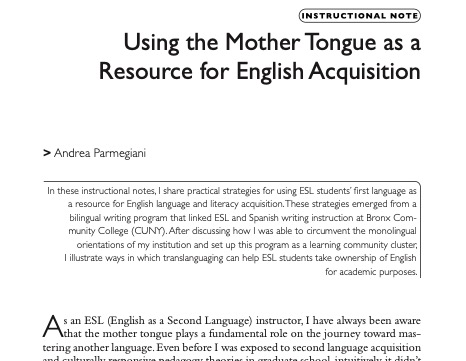16 May 2023
Andrea Parmegiani’s “Using the Mother Tongue as a Resource for English Acquisition,” published as an “Instructional Note” in Teaching English in the Two-Year College (2022), argues that “the use of ESL [English as a Second Language] students’ first languages” should be considered “resources for English acquisition,” rather than an impediment to teaching English (382). He notes that teaching in the primary language of students for whom English is a second language increases success rates (383). Community colleges regularly promote the idea of meeting students where they are, so translanguage pedagogies fit into this ideal. By “translanguage,” I refer to the theory that “boundaries among languages are porous at best, and that in the minds of bilingual and multilingual speakers, their languages form one integrated communicative system” (385).
Linked Courses between ESL and Spanish Departments
At Bronx Community College, Parmegiani helped to facilitate collaboration between ESL and the Department of Modern Languages to create course “cluster[s] linking ESL and Spanish writing instruction” (384). Students, primarily from the Dominican Republic, took a Spanish language class in the hour before the ESL class (385).
Although the Spanish language class primarily eschewed English, the students wrote papers in the thesis-driven American style (385-386). Parmegiani remarks that in their home countries, the ESL students’ prior writing experiences centered on writing “as assessment tools to test students’ ability to repeat information they were expected to learn by rote, rather than as tools for developing critical thinking skills” (386). Writing Spanish language papers in a thesis-driven format at a college in the United States helps students because they are given “the opportunity to use their mother tongue to practice unfamiliar academic writing expectations such as choosing relevant information to support a thesis and to incorporate this information into their essays without straying into plagiarism” (386). These conventions of academic writing are transferable to both academic and professional contexts.
Openness to Language Choices
In Parmegiani’s ESL class, students were expected to primarily use English in person and in writing, though it was acceptable if students used occasional Spanish words “to fill in lexical gaps in case their command of their second language just wasn’t enough to allow full self-expression” (386). Parmegiani modeled this openness to multiple languages when he attended the Spanish class prior to his ESL session and occasionally had to express himself in English rather than Spanish (386). The freedom to express thoughts in Spanish as well as English in the ESL class encouraged students to speak more, which helped them learn more because they were actively using Spanish to learn English (387).
Personal and Academic Benefits
Allowing the mother tongue in an ESL class benefits students on two levels. On a personal level, ESL students can retain a sense of pride in their background (383). Parmegiani understands that the “mother tongue is a fundamental marker of identity and the foundation of [students’] cultural capital” (383). Allowing students to use their “mother tongue” shows them respect and increases the likelihood they will stay engaged with the material.
Academically, “language and academic literacy skills can be transferred from the mother tongue to languages that are learned later in life” (383-384). Parmegiani observed that students in this linked course model “outperformed students who took the ESL course as a stand-alone class” (389). Parmegiani further reports that students in linked courses carried over success to other academic contexts, in that they “performed better in terms of average GPA, credit accumulation, and retention” (389).
Final Thoughts
I found Parmegiani’s “Instructional Note” quite compelling and interesting. I teach Writing classes in Texas and have a significant number of students who speak Spanish. I have enough Spanish-language speakers in my classes that I tell students to say words in Spanish if they are having trouble thinking of the English equivalent because generally someone in the class can translate the Spanish words into English. Like Parmegiani, I have found that this openness to students filling in gaps in English with Spanish makes students more comfortable to contribute to class discussion. I was intrigued to read how Parmegiani took this same openness to multilingual expression and coordinated with colleagues in other departments to make connections across classes.
Works Cited
Parmegiani, Andrea. “Using the Mother Tongue as a Resource for English Acquisition.” Teaching English in the Two-Year College, vol. 49, no. 4, 2022.

